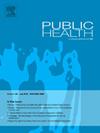2005-2020年美国成年人抑郁症状、抗抑郁药使用和心理健康咨询的全国趋势
IF 3.2
3区 医学
Q1 PUBLIC, ENVIRONMENTAL & OCCUPATIONAL HEALTH
引用次数: 0
摘要
目的:抑郁症是全球疾病负担的重要组成部分。本研究旨在监测美国成年人在抑郁症状、抗抑郁药使用和心理健康咨询方面的全国趋势,并确定需要关注的关键亚群。研究设计:连续横断面分析。方法本研究利用2005-2020年全国健康与营养调查数据。包括18岁以上的成年人,使用PHQ-9来筛选抑郁症状。排除4461名PHQ-9值缺失的参与者,分析了39,467名成年人。使用Joinpoint回归程序评估时间趋势。结果2005年至2020年,抑郁症状的患病率从21.6%上升至25.1%(趋势P = 0.009),尤其是女性和非西班牙裔白人。在药物治疗中,26.7%的抑郁症患者报告服用抗抑郁药,其中轻度使用率为21.7%,临床相关症状使用率为36.7%。调整协变量后,总体抗抑郁药物使用率从25.4%增加到30.8%(趋势P = 0.044)。与2005-2008年相比,PHQ-9≥5和≥10个体的抗抑郁药物使用分别增加了5.2%和8.8%,心理健康专业咨询率分别增加了8.0%和12.2%。结论抑郁症状的估计患病率明显增加。抗抑郁药的使用保持相对稳定,但在轻度抑郁症状的人群中可能相对较高。调整协变量后,抗抑郁药的使用在有抑郁症状的人群中显著增加。与2005-2008年相比,抑郁症状个体使用抗抑郁药和心理健康咨询的比例显著增加。紧急实施跨多个领域的干预战略是必要的。本文章由计算机程序翻译,如有差异,请以英文原文为准。
National trends in depressive symptoms, antidepressant use, and mental health consultations among US adults, 2005–2020
Objectives
Depression significantly contributes to the global disease burden. This study aims to monitor national trends in depressive symptoms, antidepressant use and mental health consultations among American adults and identify key subgroups that require attention.
Study design
Serial cross-sectional analysis.
Methods
This study utilized data from the National Health and Nutrition Examination Survey during 2005–2020. Adults over 18 were included, using the PHQ-9 to screen for depressive symptoms. Excluding 4461 participants with missing PHQ-9 values, 39,467 adults were analyzed. Temporal trends were evaluated using the Joinpoint regression program.
Results
The prevalence of depressive symptoms increased from 21.6 % to 25.1 % (P for trend = 0.009) between 2005 and 2020, particularly among females and non-Hispanic whites. In pharmacotherapy, 26.7 % of depressed individuals reported taking any antidepressants, with usage rates of 21.7 % for mild and 36.7 % for clinically relevant symptoms. After adjusting for covariates, overall antidepressant use increased from 25.4 % to 30.8 % (P for trend = 0.044). Compared with 2005–2008, antidepressant use among individuals with PHQ-9 ≥5 and ≥ 10 increased by 5.2 % and 8.8 %, respectively, while mental health professional consultation rates rose by 8.0 % and 12.2 %, respectively.
Conclusions
The estimated prevalence of depressive symptoms significantly increased. Antidepressant use remained relatively stable, but it may relatively higher among those with mild depressive symptoms. After adjusting for covariates, antidepressant use increased significantly among those with depressive symptoms. Compared with 2005–2008, rates of antidepressant use and mental health consultations among individuals with depressive symptoms increased significantly. Urgent implementation of intervention strategies across multiple domains is warranted.
求助全文
通过发布文献求助,成功后即可免费获取论文全文。
去求助
来源期刊

Public Health
医学-公共卫生、环境卫生与职业卫生
CiteScore
7.60
自引率
0.00%
发文量
280
审稿时长
37 days
期刊介绍:
Public Health is an international, multidisciplinary peer-reviewed journal. It publishes original papers, reviews and short reports on all aspects of the science, philosophy, and practice of public health.
 求助内容:
求助内容: 应助结果提醒方式:
应助结果提醒方式:


